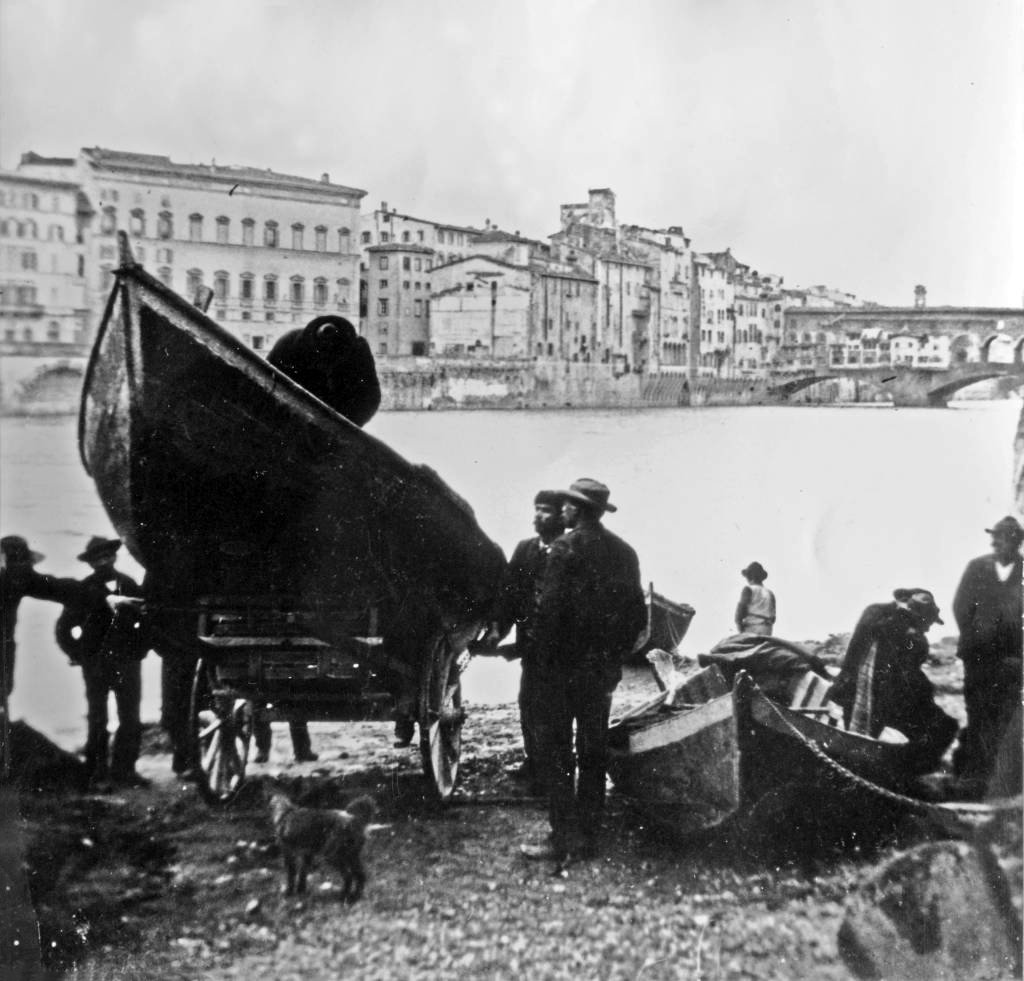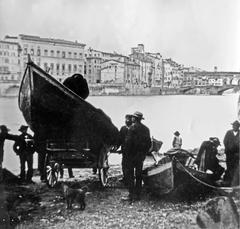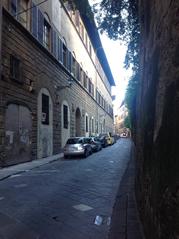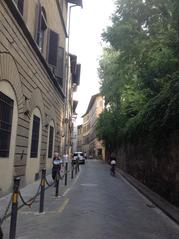
Via De’ Bardi, Florence, Italy: Visiting Hours, Tickets, and Travel Guide
Date: 15/06/2025
Introduction: Via De’ Bardi’s History and Cultural Significance
Via De’ Bardi, located in Florence’s storied Oltrarno district, is a living chronicle of the city’s journey from medieval roots to Renaissance brilliance, and into a vibrant present. Named for the powerful Bardi banking dynasty, this historic street weaves together grand architecture, artisanal traditions, and centuries-old landmarks. Its position, just steps from the Ponte Vecchio and renowned gardens like Giardino Bardini, makes it an essential destination for anyone looking to experience authentic Florence (Wikipedia; This Way to Italy; Villa Bardini Official; Michelle Altenberg).
Whether you’re intrigued by Renaissance palaces, fascinated by Florence’s merchant past, or eager to explore artisanal workshops and culinary traditions, Via De’ Bardi offers a multifaceted experience. This comprehensive guide details its history, unique attractions, visiting logistics, and insider tips to help you plan a memorable visit.
Table of Contents
- Introduction: Via De’ Bardi’s History and Significance
- Early Origins and Medieval Development
- Renaissance and Aristocratic Influence
- Urban Transformation in the 19th Century
- 20th & 21st Century Revitalization
- Visiting Via De’ Bardi: Hours, Tickets, Accessibility, and Tips
- Architectural and Social Legacy
- Recent Developments and Modern Relevance
- Unique Features: Wine Windows and Bardini Gardens
- Practical Visitor Information
- Exploring Top Attractions Near Via De’ Bardi
- Dining, Shopping, and Local Crafts
- Visitor FAQs
- Planning Your Visit: Summary and Recommendations
- References
Early Origins and Medieval Development
Via De’ Bardi’s origins stretch back to the Middle Ages, tracing the route of the ancient Via Cassia Nuova. Once known as “borgo Pidiglioso,” the area was settled by newcomers outside Florence’s city walls, earning a reputation for its humble population (Wikipedia). In the late 13th and early 14th centuries, the city’s expansion included the Oltrarno district, paving the way for the Bardi family to establish their elegant residences and transform the street into a key commercial and social artery.
Renaissance and Aristocratic Influence
During the Renaissance, Via De’ Bardi became synonymous with aristocratic opulence. The influential Bardi, Capponi, and Canigiani families built grand palaces along the street, while religious landmarks like the Church of Santa Lucia dei Magnoli received major renovations. The street’s proximity to Ponte Vecchio made it a vital link between Florence’s commercial heart and its thriving Oltrarno community (This Way to Italy).
Urban Transformation in the 19th Century
The 19th-century urban renewal led by Giuseppe Poggi fundamentally reshaped Florence. The creation of the Lungarno embankments and broad boulevards shifted the focus toward the river, while Via De’ Bardi retained its quieter, historic charm (Wikipedia). Despite modernization, the street preserved its unique blend of medieval and Renaissance character.
20th & 21st Century Revitalization
Via De’ Bardi today is a blend of restored palaces, artisan workshops, and modern amenities. Notable residents, such as writer Giovanni Papini and art historian Sir John Pope-Hennessy, reflect the street’s ongoing cultural relevance. Modern enhancements, like the installation of Giuliano Vangi’s bronze statue of Saint John the Baptist and pedestrian-friendly improvements, have further increased the area’s appeal (Wikipedia).
Visiting Via De’ Bardi: Hours, Tickets, Accessibility, and Tips
- Street Hours: Open 24/7, year-round. No ticket required for strolling Via De’ Bardi itself.
- Key Attractions: Nearby sites like Giardino Bardini and Santa Lucia dei Magnoli have specific opening hours and ticket requirements (Villa Bardini Official).
- Accessibility: While Via De’ Bardi’s cobblestones and narrow layout pose challenges, major attractions nearby offer improved accessibility.
- Guided Tours: Walking tours including Via De’ Bardi and Oltrarno are widely available and recommended for deeper insight.
- Photography: Best light is in the early morning or at sunset, especially at the junction with Lungarno Torrigiani.
- Nearby Sights: Ponte Vecchio, Bardini Gardens, Palazzo Pitti, and artisan workshops are within walking distance.
Architectural and Social Legacy
The street’s architecture is a tapestry of medieval foundations, Renaissance grandeur, and preserved merchant features like wine windows (buchette del vino). These small hatches in palazzo walls, once used for discreet wine sales, remain a living tradition (Michelle Altenberg). Via De’ Bardi encapsulates Florence’s evolving social fabric, bridging aristocratic legacy and artisan culture.
Recent Developments and Modern Relevance
Recent years have seen the area near the Torre dei Mannelli named “Piazzetta Salvatore e Wanda Ferragamo,” underscoring both the district’s fashion heritage and its ongoing vibrancy. Today, Via De’ Bardi stands as a harmonious blend of history, local commerce, and contemporary Florentine life (Wikipedia).
Unique Features: Wine Windows and Bardini Gardens
Wine Windows (Buchette del Vino)
Florence’s iconic wine windows have seen a revival in recent years. At De’ Bardi Ristorante (Via de’ Bardi 25R), you can experience this tradition firsthand—enjoying Tuscan wines served through a restored buchetta, a unique link to Florence’s mercantile past (Michelle Altenberg; thebackpackermom.com).
Giardino Bardini
A highlight of the area, Giardino Bardini offers panoramic views, ornate staircases, lush gardens, and seasonal wisteria blooms. Open daily (10:00 am–8:00 pm), with last entry an hour before closing; tickets are €10, with discounts for EU residents aged 18–24 (Villa Bardini Official).
Practical Visitor Information
- Getting There: Easily reached on foot from the Ponte Vecchio or by bus lines 7 and C1. Limited parking is available at Parcheggio Porta Romana.
- Dining: Local restaurants serve Florentine specialties; reservations are advised for popular venues.
- Shopping: Artisan workshops and boutiques in the Oltrarno offer handcrafted goods and local crafts (Condé Nast Traveller).
- Facilities: Public restrooms are limited—use those in restaurants, cafes, or nearby museums when needed.
- Safety: Via De’ Bardi is safe, but remain vigilant against pickpocketing in crowded areas (We Are Travel Girls).
Exploring Top Attractions Near Via De’ Bardi
- Ponte Vecchio: Florence’s oldest and most iconic bridge, famed for its jewelry shops and medieval architecture (Nomadic Matt).
- Uffizi Gallery & Vasari Corridor: Home to world-class Renaissance art and a historic passage once reserved for the Medici (mapcarta.com).
- Museo Galileo: Showcasing Florence’s scientific achievements, with original instruments of Galileo (mapcarta.com).
- Palazzi & Churches: Admire the façades of Palazzo Capponi da Uzzano and the historic Church of Santa Lucia dei Magnoli (palazzocapponiallerovinate.com).
Dining, Shopping, and Local Crafts
Via De’ Bardi and the Oltrarno district are renowned for artisan workshops—leather goods, jewelry, bookbinding, and more. Local trattorias serve classic Tuscan dishes such as ribollita and bistecca alla Fiorentina. For a memorable meal, consider the terrace of La Loggetta in Giardino Bardini or the traditional atmosphere of De’ Bardi Ristorante (The Tour Guy).
Visitor FAQs
Is entrance to Via De’ Bardi free?
Yes, Via De’ Bardi is a public street—no tickets required.
Are there accessible routes for wheelchairs?
The street is moderately accessible; nearby attractions like Giardino Bardini offer ramps and accessible entrances (Villa Bardini Official).
Is a guided tour recommended?
Absolutely—guided tours provide rich historical context and access to hidden gems.
When is the best time to visit?
Spring and early autumn offer pleasant weather and fewer crowds; early morning or sunset are ideal for photos.
What is a wine window and where can I find one?
A wine window (buchetta del vino) is a small opening in a palazzo’s wall used for wine sales. Visit De’ Bardi Ristorante to experience this tradition (Michelle Altenberg).
Planning Your Visit: Summary and Recommendations
Via De’ Bardi is a microcosm of Florence—melding medieval roots, Renaissance artistry, and ongoing local traditions. Its accessible location, proximity to top attractions, and rich blend of history and living culture make it a must-see for visitors seeking an authentic Florentine experience.
Top Tips:
- Explore with a guided tour for deeper insight.
- Visit Giardino Bardini for panoramic views and seasonal blooms.
- Sample local wines at a traditional wine window.
- Wander artisan workshops and enjoy authentic Tuscan cuisine.
- Use the Audiala app for curated walking tours and up-to-date tips.
For further planning, consult official resources and local guides (The Florence Insider; We Are Travel Girls).
References
- Wikipedia: Via de’ Bardi
- This Way to Italy: Most Iconic Streets in Florence
- Villa Bardini Official: Organize Your Visit
- Michelle Altenberg: Wine Window Florence
- The Florence Insider: Tips for Visiting Florence
- We Are Travel Girls: Florence Italy Top Tips
- Condé Nast Traveller: Florence Travel Guide
- The Tour Guy: Things to Do Off the Beaten Path in Florence
- palazzocapponiallerovinate.com: Palazzo Capponi da Uzzano









































































